 The most impressive detail for the imagination of the brothers Masons is the apron they wear as a distinctive sign and an initiatory symbol of Freemasonry in its three degrees of abilities, qualities and virtues. The Apron of Art, therefore, is a historical element of the ‘operative’ tradition which, with the advent of speculative Freemasonry, took the value of initiatory symbol. The most impressive detail for the imagination of the brothers Masons is the apron they wear as a distinctive sign and an initiatory symbol of Freemasonry in its three degrees of abilities, qualities and virtues. The Apron of Art, therefore, is a historical element of the ‘operative’ tradition which, with the advent of speculative Freemasonry, took the value of initiatory symbol.
Esotericism of the Masonic Apron
by Athos A. Altomonte
© copyright by Esonet.it - Esonet.com
Esonet Conferences
"ESOTERICISM OF THE MASONIC APRON"
Author and speaker: Athos. A. Altomonte
Civitavecchia, Sunbay Park Hotel, 15 th March 2003
Index: Distinctive sign and initiatory symbol – Hierophants– The Tour de France – Geometry of the Apron – The triangle and the square
Distinctive sign and initiatory symbol
The most impressive detail for the imagination of the brothers Masons is the apron they wear as a distinctive sign and an initiatory symbol of Freemasonry in its three degrees of abilities, qualities and virtues.
It is a ‘cloth' 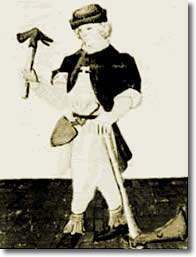 that reminds of the operative builders in the Middle Ages and the builders of the Temple of Jerusalem , wanted by King David and finished by his son Solomon. that reminds of the operative builders in the Middle Ages and the builders of the Temple of Jerusalem , wanted by King David and finished by his son Solomon.
The Architect Hiram Abif supervised the work of construction of the first Temple of Jerusalem , and he was the Master and moral guide of all the lesser builders, of all degrees and qualities.
Master Hiram, killed by three Bad Companions, sacrificed his own life to keep the ‘secret on the work accomplished', of which he didn't want to reveal the Pass Word. Therefore he became the symbol of spirituality of the Ars Muratoria, and a central figure of the myth of Masonic masterhood .
Hiram, the Architect, distinguished the legions of his workmen in three categories: Entered Apprentice, Fellow Craft and Master Mason . This classification still exists in Blue Freemasonry.
Superintendent and auditor Architects disciplined the three degrees; they guaranteed the rhythm and quality of the Work, with rules and instruments still existing in the Masonic Temples.
Workmen, Masters and Architects recognized themselves with secret Signs and Touches, together with Pass Words used to access the most secret compartments of the sacred buildings (see Middle Chamber ).
Still today secret signs, touches and words are used to distinguish people belonging to the different degrees of the Masonic Pyramid .
The Builders Brotherhood born around the pyramids started further east. In memory of its origin the formula ‘as the sun rises from the east, so wisdom comes from the Orient' was created.
Initiatory meetings have the common purpose of accepting postulants only after they have passed the required trials, which vary from one meeting to another. But a common rule is the oath of silence on what is learnt and the secret on the work accomplished.
To build a sacred building with Stone means to give material form to a Divine idea. Pursuing this purpose, the initiations of builders took different directions.
The basic initiations were professional ones, but the best workmen could aspire to the ‘introduction' to lesser mysteries. In the classes of material executors they were used to improve the knowledge of the architectonic ideograms to which they would later dedicate their work.
The initiations to greater mysteries, on the other hand, were addressed to the creators of the projects. They implied a direct approach to the knowledge reserved to the Sacerdotal Cast, whose main depositaries were Hierophants* , depositaries of the Teachings of the Temple , the only ones who could initiate the best among them.
__________
* Hierophants ( from which the term hieratic ). – H. were priests and initiates who didn't promote any contact with those who, amplifying popular beliefs, spread exoteric religious criteria. They were initiates who didn't follow exterior cults, which were destined to the people, because they were the heirs of a spirituality that pursued inner illumination, which descended from a principle of divinity and didn't accept the adoration of material principles ( exterior knowledge, material divinity ).
Hierophants were initiators of inner principles , therefore invisible and believed to be secret. They were builders of ideal bridges used to link their own inner sky ( the plane of divine conscience ) to mental matter ( the plane of physical conscience ) up to inflaming it and producing, in actual fact, illumination. Initiators inflamed the physical conscience ( the earth ) and, thorugh the principles of a Secret Doctrine , reached a very high ritual and theurgic condition, which expressed the assonance of gestures-sounds and words that was the prerogative of the highest degrees of the initiatory hierarchy. Inflaming the ‘inner earth' of the inititate is the supreme ritual action that concludes the most sacred actions: the consecration of the living matter . To the ordinary observer, this made the initiate a semigod or a messenger of God, as in the following statement: the divinities walked amongst men.
__________
In the west as well the Builders of sacred forms were Initiates who, with ‘ sacrum facere ' planned the geometries that reproduced divine ideas in stone. Therefore in the west,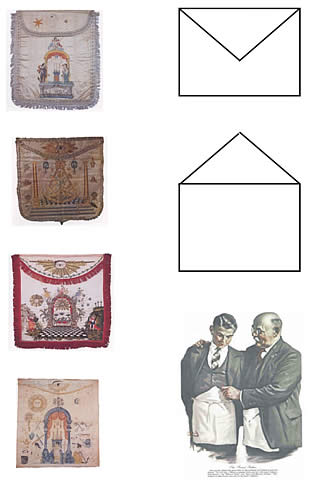 like in the east, the buildings became great ‘Books of Stone' that showed God's goals on earth. like in the east, the buildings became great ‘Books of Stone' that showed God's goals on earth.
In order for the principles of the Secret Doctrine not to be used for profane purposes, the features of the Great Work transmitted from Hebrew mysticism were re-veiled (veiled twice) in the geometries of the buildings (such as the Sephirotic Tree inscribed on the façade of Cathedrals), in secret monograms and pass words, in mysterious signs and all the sacred fittings whose meanings remain impenetrable to the eyes of those non-introduced to the mysteries. Nevertheless, in the east as well as in the west, the great ‘Books of Stone' keep transmitting the spirit of the Secret Doctrine of Hierophants, indifferent to time and space.
Pictures and miniatures show us workmen using tools to erect Temples for ‘the Glory of God'. The workmen tied round their waist lambskin aprons to protect themselves from the blows of tools and splinters.
Therefore the Art Apron is a historical element of the ‘operative' tradition which, with the advent of speculative Freemasonry took the value of initiatory symbol. It wasn't an operative cloth anymore, but together with a band of chivalrious origins, it became a picture that illustrated the esoteric elements of a Masonic degree or office. This happened in Blue Freemasonry as well as in Red, Black and White Freemasonry and in every other Rite, where band and apron became distinctive signs of Masonic dignity .
Linking the belt that allows to tie it around the waist with the ‘sign of master mason', the analogy with the ‘chastity' belt of the Chivalrious Orders, mystic and templar, results obvious. That is, the ritual and religious clothing expresses the detachment from sexual confusion and direct the energies towards the intellect, therefore with purposes other than pleasure and material generation. The belt is the symbol of a refined purity that reminds us of the mystical afflatus that animated the Ancient initiatory Observances.
The Tour de France
The Tour de France is known to the general public for an international cyclistic event. Originally, though, the ‘Tour de France' was a journey of craftsmanship perfectioning , through which the apprentice became compagnon and then accomplished compagnon .
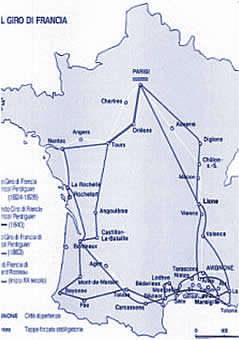 By traveling three times the periplus of the journey, the compagnons went from a building to another, from a church to a cathedral; an experience after another they reached the masterhood in the art of building. By traveling three times the periplus of the journey, the compagnons went from a building to another, from a church to a cathedral; an experience after another they reached the masterhood in the art of building.
The term compagnon comes from the Latin ‘ cum panis ', which means ‘ he who shares the bread '. From here the French word ‘ compain ' that means companion.
Compagnons accepted the rules of community life; they shared all the precepts and secrets of the craft. This brings us back to the principle of brotherly sharing , which was a fundament of the templar Rule. It was represented by two people eating from the same bowl and riding the same horse (see Templar seal ).
The assonance exists, because the Builders of Cathedrals belonged to the Templar Order, whose affiliates instructed the most expert workmen.
Therefore the tour transformed the compagnons in craftsmen, using an exquisitely professional initiatory journey.
But the initiatory model of craftsmen Confraternites and workers Guilds changed a lot with the political upsetting that followed the ruin of the Templar Order.
Illustrious members of the Order, such as architects, researchers, alchemists that moulded metals, bankers of Commendams, together with many knights went on voluntary exile, to avoid the sovereign avidity (of King Philip the Fair) and religious persecution (of Pope Clement V, elected with the approval of the French King.
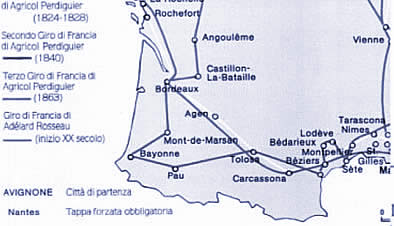
But not all of them left. Many asked for asylum to the workers Confraternites , where they profused their initiatory knowledge by spreading the symbolism of their ‘mysteries' among the Freemasons.
This fusion determined the advent of the cultural phenomenon called speculative Freemasonry. Thanks to the intellectual drive of the ‘deserters' of other Orders, Freemasonry modified its mysteric asset by changing its initiatory address, which from initiatory became humanistic, philosophical and scientific.
The approach of ‘Illuminated' Brothers changed the old ritual feature. Among those who determined this change we must mention the English Elias Ashmole (see The Rose & Cross Confraternite ), a 17 th century rusicrucian , who enriched speculative Freemasonry of the 3 rd degree, Master Mason. He gave this degree a singular spiritual peculiarity. His ritual mysticism expresses indeed concepts that don't belong to the ‘craftsman'. So much so that in the ceremony for the constitution of the new master, the spiritual resurrection of Master Hiram is represented.
Once the function of physical protection disappeared, the size of the apron was adapted to a symbolic function. Between the 18 th and 19 th centuries, its dimensions were brought at 35-40 cm by 35-40 cm. These numbers expressed an ancient standard of initiatory tradition, which considered the age of 35-40 as the age of maturity, therefore the ‘right age' to enter the mysteries of the Temple , where the secrets of the Art turned from physical to intellectual.
And ‘ …the stone was not stone any more… ' but it became the symbol of human temperament, to be smoothed down in order to fit other brotherly stones. It allows to recognize the principle of Brotherly and Universal Cohesion , which is represented by the grains of a pomegranate .
Geometry of the Apron
The apron is made of three parts: a square basis, a triangular bib and a belt. Apprentices and Fellows wear white leather or satin aprons without any decoration. The Masters' apron has a red hem and it is variedly ornated with cockades or Taus , or decorated with two red letters ‘ M' (Mac) and ‘ B ' ( Benac ) , representing the Lost Word.
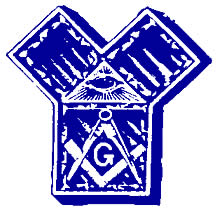 The shape of the apron doesn't change in the three Degrees, but it has different meanings depending on the Mason's degree and functions. The shape of the apron doesn't change in the three Degrees, but it has different meanings depending on the Mason's degree and functions.
The square at the basis and the triangle of the bib as well as the geometrical and mathematical value (see picture), are the representation of the seven levels of conscience, through which one can ascend to the seven Liberal arts: grammar, rethorics , oratory, arithmetic, music, astronomy and geometry. Referring to the precept by which: ‘God, by creating, geometrizes the universe', the geometric aspect was placed at the top of an ideal scale of knowledge, and the letter G is accompanied by the Flaming Pentalpha , symbol of the highest initiation.
Grammar, rethorics and dialectics made the so-called Trivium . It is fundamental for knowledge because without rules in the language there can't be any understanding or communication. Therefore, in order to give a right and perfect form to the thought, it is fundamental to master the language and to have an expert use of the verbal instrument. In order to learn, one must learn to be silent and listen first.
Triangle and Square
The triangle and square of the apron add up to form the pentagon, which joins the quaternary of physical matter to the triangle of divine perfection.
The sacred numbers that correspond to this ‘form' are 3, 4 and 5, which are respectively broken up in 1 + 2 / 3 + 1 / 3 + 2. From the numbers 3 + 4 + 5 originates 12, which can be brought back (1 + 2) to the number 3, symbol of the spiritual ternary.
The square represents the quaternary of the four elements: earth ( minerals of the skeleton, bones, physical conscience ), water ( physical fluids, emotional conscience ), air ( mind, abstract thought ), fire ( energy, spiritual conscience ). The meaning of the four elements, dealt with in the previous conference (see Esotericism of the four Journeys of Masonic Initiation ) have been hidden in the metaphor of the four evangelists and the four animals that veil four zodiac cycles, corresponding to the four eras.
Earth and water correspond to the physical-emotional side of personality, which the mind must learn to discipline and control. By dominating the energetic ganglia that give the impulse to the lower elements, placed below the belt, the attention of the initiate is brought to the top, viz. towards the triad represented by the triangle of the bib.

Among the meanings of the ‘Quaternary' ( earth, water, air and fire ) we find the four stages of life: childhood, youth, maturity and old age. Then we find the four cardinal points, with top, bottom, right (masculine) and left (feminine), used for inner orientation. Furthermore, we have the ciclicity of the four seasons and the four Eras, which ancient concepts divided into Age of Gold, of Silver , of Bronze and of Iron .
Here we can have an outline of the initiatory ‘design' shown to Masons. It is a ‘journey' that leads to the sublimation of the elements of the material quaternary into the higher triangle.
In order to obtain this, a process of inner metamorphosis is necessary; hermeticists call it metallic transmutation (see Metallic transmutation ). It transforms heavy sensations of the passional nature in the igneous thoughts of the spiritual wil , up to the Pure Reason.
The water element, going up to the fire element ( spiritual conscience ) creates an unfortunate effect, which alchemists call astral vapor. They are the fogs of illusion where the ‘Traveler' can get lost; they are resolved in the alchemic formula: ‘ solve et coagula ', in order to make the ‘humid path' of physical conscience dry and solar.
This allows us to consider another aspect: the dry and humid Paths are not a reference to the Traveler's sex, but to his conscience, lunar if it is physical and solar if it is illuminated by the superior triad.
The colors of the apron reinforce the concept; the black color on the inside represents the (symbolic) annulment of any undesirable emotional color that might be released by the lower centers of personality; the white color on the outside represents the refraction of intellectual energies in those centers.
The belt, which separates the apron in two, highlights the division between triad and quaternary, which must be overcome with a ‘bridge' that creates the inversion of conscience reproduced by the lowering of the bib in the lower quaternary. It represents another stage of the initiatory journey, where will and intellect descend to balance the chaos of instincts.
Nevertheless these representations are purely symbolic. But they can be seen as the indication of what can be done by smoothing one's own stone, rounding off the edges in order to exhalt the subtlest sides of ourselves. Therefore to smooth one's temperament means to transform the lead of material nature into the gold of subtle conscience. This is the task of those who want to become true initiates, who don't build stone cathedrals any more, but inner Temples; they are is aware that they are using fragments of conscience rather than instruments that produce splinters.
The first instruments of the initiate are fair thought , based on intelligent love; fair speech , ruled by self-control; fair actions , based on the understanding of laws, even super-sensitive. As mentioned in ancient rules they are the tools for initiates that don't adorn themselves with jewels, but with tolerance, silence and initiatory uniformity .
The triangle that ‘descends' in the square implies a first contact between physical and subtle conscience in the re-unification of the two poles ( masculine-feminine ) that make the human nature. This happens through the construction of a conscience segment that a metaphor calls ‘Bridge' or ‘Royal Arch', viz. Ars Regia . The building of inner bridges is a prerogative of pontiffs ( pontifex ), high value initiates able to re-join the ‘top to the bottom' following the rule of ‘ as above as below ', who can reflect the inner sky in the earth of physical matter.
To make the idea even clearer, the French word for apron helps; it is called ‘ tablier ', which means ‘table or bridge'. It reminds us that all initiatory cultures have always used the bridge to represent the passage from a profane ( unconscious, sleeping ) state to the inititate ( conscious, awaken, re-born ) state.
In the Masonic apron as well the white and black colors indicate a state of latent duality between two opposite poles. It is a conflict that can be resolved through the ability to discriminate ( symbol: sword ) and fair judgement ( symbol: scales ), which generates the balance that makes opposites complementary. Indeed, intellectual balance creates a third mental pole (see synthesis ) that annuls the two apparently irreconciliable aspects of masculine and feminine .
 Once reached the balance between ‘different drives' the physical senses are not the only means of conscience enquiry any more. But mental synthesis becomes a point of conscious recognition , able to evolve up to becoming the dominating principle through which there can be the expression of a conscience that, not dominated by the drives of the lower nature any more, can reflect itself in the intellect . Once reached the balance between ‘different drives' the physical senses are not the only means of conscience enquiry any more. But mental synthesis becomes a point of conscious recognition , able to evolve up to becoming the dominating principle through which there can be the expression of a conscience that, not dominated by the drives of the lower nature any more, can reflect itself in the intellect .
This creates a mental point (see egoic barycenter in the article The Middle Way ) that enlightens the physical conscience, creating an effect represented by the Pentalpha or Flaming Star.
A very few Masons are introduced to this last part of the initiatory journey. Perhaps because these meanings are far away from the most traditional aspect of Freemasonry; it is more infused with religious devotion rather than initiatory science.
Religious sentiment is a common aspect in every level of Freemasonry, in each office and ritual action. The presence of a religious soul in Freemasonry can't be ignored. Indeed, it must be analyzed to understand its deepest aspects.
The investigation into the devotional aspect of Freemasonry is the subject of a work where the ignored religiosity of Freemasonry has been studied.
| 

